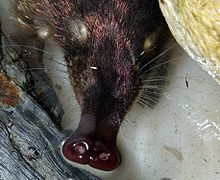Pyrenees Desman
| Pyrenees Desman | ||||||||||||
|---|---|---|---|---|---|---|---|---|---|---|---|---|

Pyrenean desman ( Galemys pyrenaicus ) |
||||||||||||
| Systematics | ||||||||||||
|
||||||||||||
| Scientific name of the genus | ||||||||||||
| Galemys | ||||||||||||
| Kaup , 1829 | ||||||||||||
| Scientific name of the species | ||||||||||||
| Galemys pyrenaicus | ||||||||||||
| ( E. Geoffroy , 1811) |
The Pyrenean Desman or Almizclero ( Galemys pyrenaicus ) is a species of mammal from the mole family (Talpidae). Together with the Russian Desman , he forms the group of Desmane (Desmanini), who of all moles are most strongly adapted to a water-dwelling way of life.
features
The Pyrenean Desman reaches a head body length of 11 to 16 centimeters and weighs 40 to 80 grams. The long nose, composed of two cartilaginous tubes and bare except for a few whiskers, which protrudes far beyond the lower lip, is very flexible and resembles a small trunk. The tail is just as long as the body (12 to 15 centimeters) and flattened on the sides. The hind feet are webbed and have additional bristle hairs on the sides. The Pyrenean Desman has small eyes and the ears are almost entirely hidden in the fur. This has a short, dense, plush undercoat and long, stiff protective hair. It is red-brown on the top and ash-gray on the belly. The Pyrenean Desman has a scent gland on the underside of its tail, from which it secretes a musk-like secretion.
distribution and habitat
Pyrenees desmane live in the Pyrenees between France and Spain and in a strip in the northern mountainous region of the Iberian Peninsula as far as Portugal . They are mainly found in fast flowing, clear mountain streams at an altitude of 300 to 1,200 meters. But they have also been observed in mountain lakes, in streams at 2,200 meters above sea level and in rivers on the plain.
Way of life and food
Pyrenean desmans usually do not dig their own burrows, but use crevices, caves in the ground or the burrows of water voles . Unlike many other insectivores , they mostly live in pairs, with the larger territory of a male completely overlapping the smaller of a female. However, there are also solitary animals of both sexes. The territorial boundaries are marked with the secretion of their tail gland and vehemently defended against same-sex conspecifics.
These animals are nocturnal. During the day they sleep in their shelters, at night they go in search of food. You can swim excellently, especially the hind legs provide propulsion. Found prey is brought ashore and consumed there.
The diet of the Pyrenees desmane consists of insect larvae, crustaceans, worms, but also small vertebrates such as fish and small rodents.
Reproduction
Pyrenees desmans mate in spring, but sometimes as early as January. After a gestation period of around thirty days, the female gives birth to 1 to 5 (average 3.6) blind, toothless and almost naked young. These are suckled for about a month and reach sexual maturity in the second year of life.
threat
The threats to the Pyrenees desmans include water pollution, habitat fragmentation and persecution by fishermen who see them as food competitors. Added to this is the displacement by the American mink , which - broken out of fur farms or released - occupies a similar ecological niche as the Desmane. Parts of its distribution area are protected as national parks, overall the IUCN lists the species as endangered ( vulnerable ).
The species is listed by the European Union in Annexes II and IV of the Habitats Directive and is therefore a species of community interest that must be strictly protected, and special protected areas must be designated for their preservation.
literature
- Ronald M. Nowak: Walker's Mammals of the World. 2 volumes. 6th edition. The Johns Hopkins University Press, Baltimore MD et al. 1999, ISBN 0-8018-5789-9 .
Web links
- Galemys pyrenaicus in the endangered Red List species the IUCN 2006. Posted by: Insectivore Specialist Group, 1996. Retrieved on 11 May, 2006.

